
The Doge's Palace is a palace built in Venetian Gothic style, and one of the main landmarks of the city of Venice in northern Italy. The palace was the residence of the Doge of Venice, the supreme authority of the former Republic of Venice. It was built in 1340 and extended and modified in the following centuries. It became a museum in 1923 and is one of the 11 museums run by the Fondazione Musei Civici di Venezia.
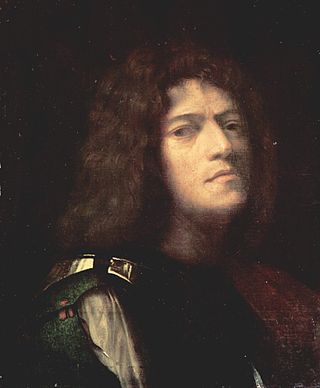
Giorgio Barbarelli da Castelfranco, known as Giorgione, was an Italian painter of the Venetian school during the High Renaissance, who died in his thirties. He is known for the elusive poetic quality of his work, though only about six surviving paintings are firmly attributed to him. The uncertainty surrounding the identity and meaning of his work has made Giorgione one of the most mysterious figures in European art.

Giovanni Battista Tiepolo, also known as GiambattistaTiepolo, was an Italian painter and printmaker from the Republic of Venice who painted in the Rococo style, considered an important member of the 18th-century Venetian school. He was prolific, and worked not only in Italy, but also in Germany and Spain.

Paolo Caliari, known as Paolo Veronese, was an Italian Renaissance painter based in Venice, known for extremely large history paintings of religion and mythology, such as The Wedding at Cana (1563) and The Feast in the House of Levi (1573). Included with Titian, a generation older, and Tintoretto, a decade senior, Veronese is one of the "great trio that dominated Venetian painting of the cinquecento" and the Late Renaissance in the 16th century. Known as a supreme colorist, and after an early period with Mannerism, Paolo Veronese developed a naturalist style of painting, influenced by Titian.

Lorenzo Lotto was an Italian Renaissance painter, draughtsman, and illustrator, traditionally placed in the Venetian school, though much of his career was spent in other north Italian cities. He painted mainly altarpieces, religious subjects and portraits. He was active during the High Renaissance and the first half of the Mannerist period, but his work maintained a generally similar High Renaissance style throughout his career, although his nervous and eccentric posings and distortions represented a transitional stage to the Florentine and Roman Mannerists.

Ca' Rezzonico is a palazzo and art museum on the Grand Canal in the Dorsoduro sestiere of Venice, Italy. It is a particularly notable example of the 18th century Venetian baroque and rococo architecture and interior decoration, and displays paintings by the leading Venetian painters of the period, including Francesco Guardi and Giambattista Tiepolo. It is a public museum dedicated to 18th-century Venice and one of the 11 venues managed by the Fondazione Musei Civici di Venezia.

Sophia is a central idea in Hellenistic philosophy and religion, Platonism, Gnosticism and Christian theology. Originally carrying a meaning of "cleverness, skill", the later meaning of the term, close to the meaning of phronesis, was significantly shaped by the term philosophía as used by Plato.

Sebastiano Ricci was an Italian painter of the late Baroque school of Venice. About the same age as Piazzetta, and an elder contemporary of Tiepolo, he represents a late version of the vigorous and luminous Cortonesque style of grand manner fresco painting.
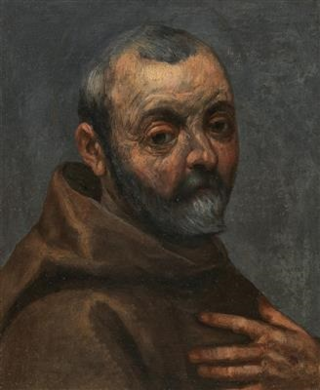
Iacopo Negretti, best known as Jacopo or Giacomo Palma il Giovane or simply Palma Giovane, was an Italian painter from Venice and a notable exponent of the Venetian school.
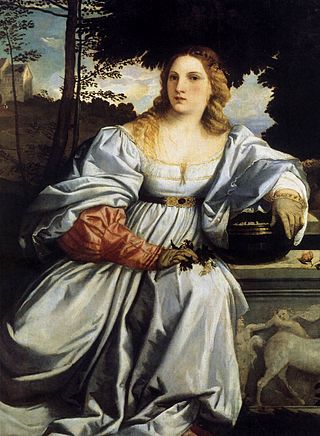
Sacred and Profane Love is an oil painting by Titian, probably painted in 1514, early in his career. The painting is presumed to have been commissioned by Niccolò Aurelio, a secretary to the Venetian Council of Ten, whose coat of arms appears on the sarcophagus or fountain, to celebrate his marriage to a young widow, Laura Bagarotto. It perhaps depicts a figure representing the bride dressed in white, sitting beside Cupid and accompanied by the goddess Venus.
Events from the year 1565 in art.

The Feast in the House of Levi or Christ in the House of Levi is a 1573 oil painting by Italian painter Paolo Veronese and one of the largest canvases of the 16th century, measuring 560 cm × 1,309 cm. It is now in the Gallerie dell'Accademia in Venice. It was painted by Veronese for a wall of a Dominican friary called the refectory of the Basilica di Santi Giovanni e Paolo.
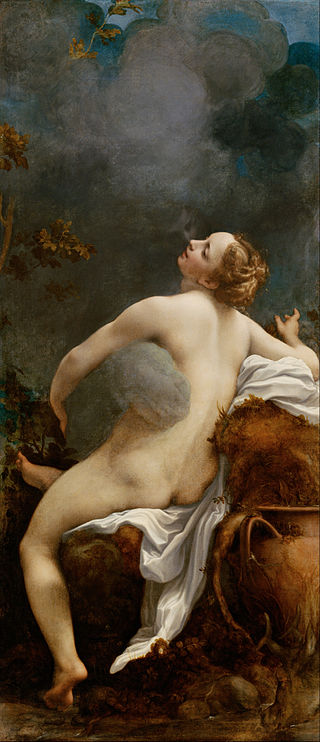
The Orleans Collection was a very important collection of over 500 paintings formed by Philippe II, Duke of Orléans, mostly acquired between about 1700 and his death in 1723. Apart from the great royal-become-national collections of Europe it is arguably the greatest private collection of Western art, especially Italian, ever assembled, and probably the most famous, helped by the fact that most of the collection has been accessible to the public since it was formed, whether in Paris, or subsequently in London, Edinburgh and elsewhere.

Venetian painting was a major force in Italian Renaissance painting and beyond. Beginning with the work of Giovanni Bellini and his brother Gentile Bellini and their workshops, the major artists of the Venetian school included Giorgione, Titian, Tintoretto (1518–1594), Paolo Veronese (1528–1588) and Jacopo Bassano (1510–1592) and his sons. Considered to give primacy to colour over line, the tradition of the Venetian school contrasted with the Mannerism prevalent in the rest of Italy. The Venetian style exerted great influence upon the subsequent development of Western painting.

Allegory of Virtue and Vice, also known as The Choice Between Virtue and Vice or The Choice of Hercules is a painting by Paolo Veronese, created c. 1565 in Venice, Italy. It is now located in the Frick Collection, in New York. It is a large-scale allegorical painting depicting Hercules' struggle between virtue and vice, personified here by the figures of the two women physically pulling him in different directions.

Pauwels Franck, known in Italy as Paolo Fiammingo and Paolo Franceschi, was a Flemish painter, who, after training in Antwerp, was active in Venice for most of his life. He is mainly known for his landscapes with mythological, allegorical and religious scenes. He worked in a Mannerist style showing the influence of Tintoretto, Veronese, and Bassano.

The Conversion of Mary Magdalene is an oil painting, an early work by the Italian Renaissance artist based in Venice, Paolo Veronese (1528–1588). He was known for his sumptuous paintings with a dramatic and colourful style. Dating from circa 1545–1548, the painting was commissioned by a noble patron in Verona. It is held by the National Gallery in London.
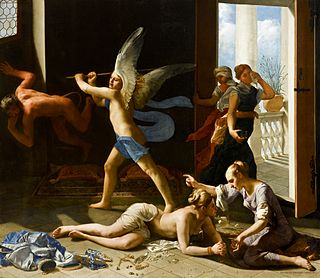
The Repentant Magdalene, also called The Conversion of Mary Magdalene, is an oil painting of the early 1660s by the Baroque Italian painter Guido Cagnacci. It shows Mary Magdalene, beside her remonstrating sister Martha, at the moment she repents, echoed by an allegorical pairing of Virtue, an angel, chasing out Vice, a devil. The painting is at the collection of the Norton Simon Museum, in Pasadena.

Venus and Mars is an oil painting on canvas painted in the 1570s by the Italian Renaissance artist Paolo Veronese.

Hercules at the crossroads, also known as the Choice of Hercules and the Judgement of Hercules, is an ancient Greek parable attributed to Prodicus and known from Xenophon. It concerns the young Heracles/Hercules who is offered a choice between Vice and Virtue—a life of pleasure or one of hardship and honour. In the early modern period it became a popular motif in Western art.



















